Summary of climate disasters on the planet from June 19 to 26, 2024
USA
From June 20 to June 24, endless rains in the Midwest USA caused historic floods, resulting in significant damage and evacuation of residents. Two people died as a result of the natural disaster. At least twenty rivers reached historic water levels.
A state of emergency was declared in Iowa. On June 22 alone, rescuers conducted 250 water rescues. Governor Reynolds described the situation as "staggering"; many towns were left without electricity, water, and sewage services, hospitals and nursing homes were evacuated, businesses closed.
Disaster warnings covered 25 counties.
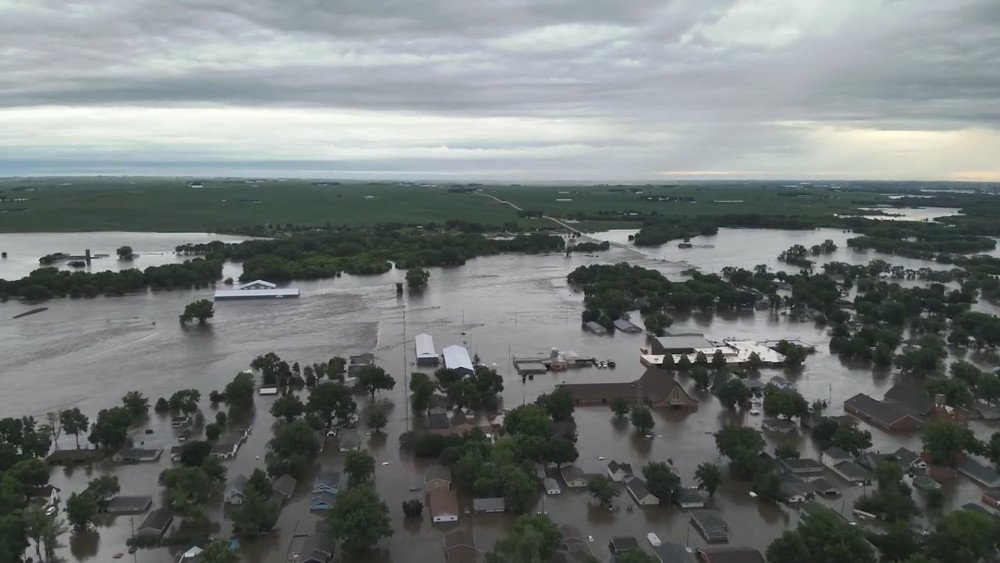
Major flood in Rock Valley, Iowa, USA
In Rock Valley, a dam breach early in the morning led to the urgent evacuation of residents. Roads and at least two bridges were washed away. City authorities even activated tornado sirens, to alert citizens of the dangerous situation. The Rock River reached a historic level of 8.42 meters, which is 1.52 meters higher than the previous record.
In Lyon County, a train was derailed, and nine train cars were swept away by the floodwaters.
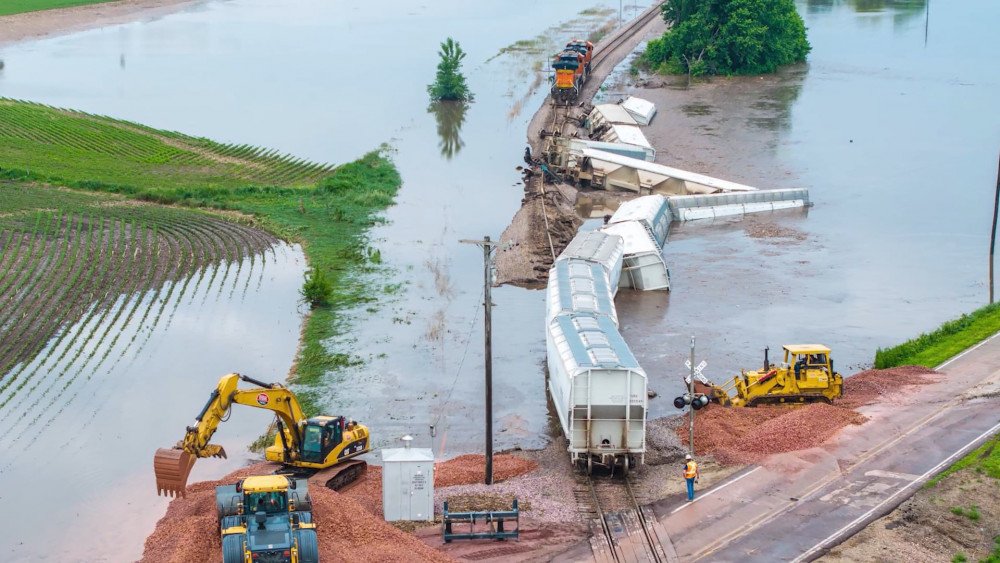
Nine train cars were swept away by floodwaters, Lyon County, Iowa, USA
The flood damaged more than 1,900 buildings, hundreds of which were completely destroyed. Many towns in the state were left without electricity, drinking water, and sewage. Hospitals and nursing homes were evacuated.
The National Weather Service reported that two cities in South Dakota, Sioux Falls and Mitchell, affected by the floods, on June 20-21 saw
the wettest two-day periods on record.
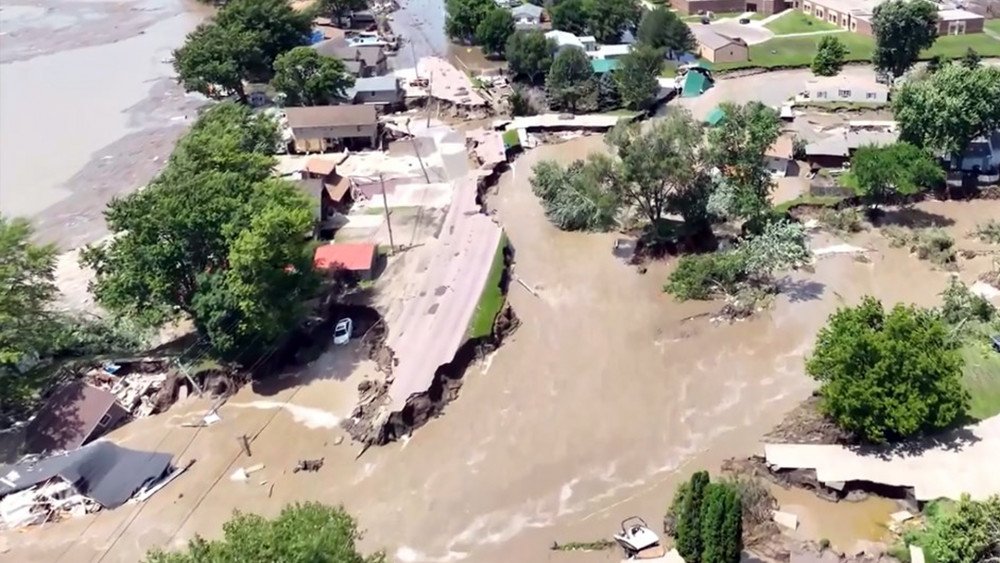
Vast destruction from the flood, USA
According to the BNSF Railway Company, a section of a railroad bridge over the Big Sioux River in South Dakota collapsed on the evening of June 23 due to the flood.
In Minnesota, the Rapidan Dam partially burst, and water flows rushed downstream into populated areas, destroying a power substation. Water also eroded the soil under a riverside house and caused it to collapse into the river.
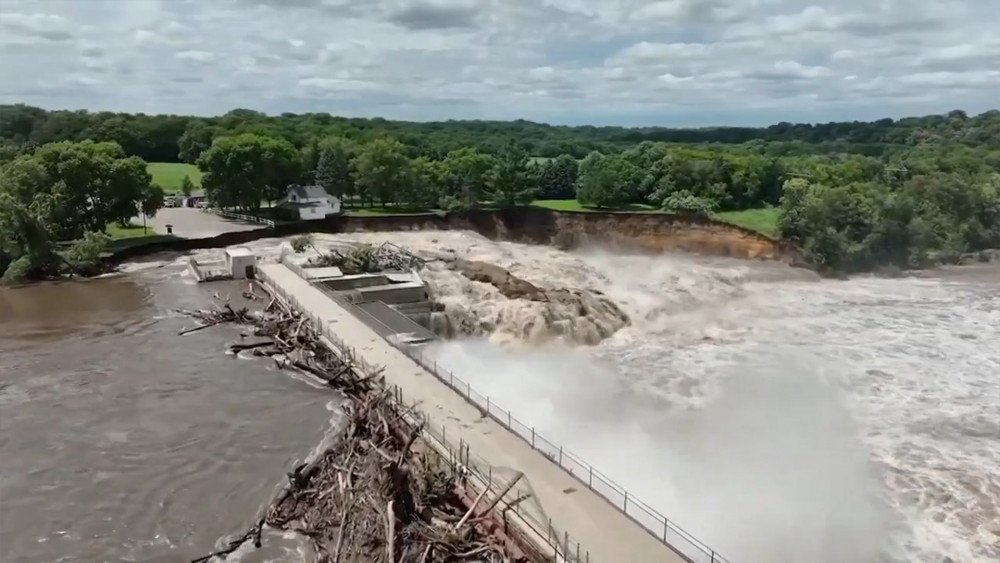
The river breached the Rapidan Dam, Minnesota, USA
During the deadly floods, the National Weather Service experienced a major data failure. As a result, meteorologists did not have access to critical information needed for weather forecasts and warnings about life-threatening climate events.
Azerbaijan
During several days starting from June 20, storms, heavy rains, and hail raged in Azerbaijan. The Gazakh, Tovuz, Shamkir districts, and the city of Ganja were particularly affected.
They caused significant damage to the country's western regions.
Wind tore off roofs, felled age-old trees onto cars, buildings, and roads.
17,000 people experienced power outages.
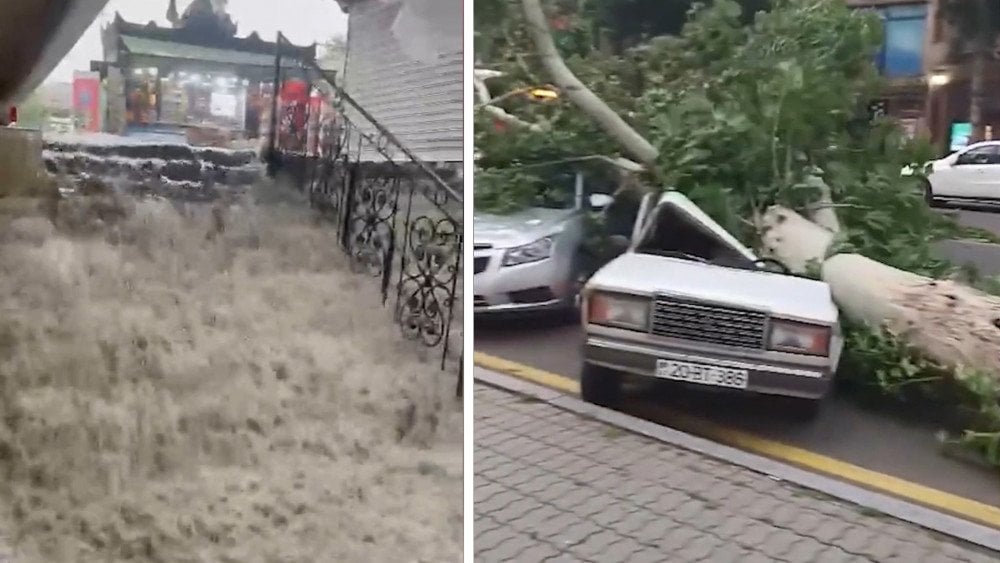
Aftermath of a devastating storm, Azerbaijan
In the city of Ganja, mudflows flooded streets, many yards, and houses.
Due to the fury of the natural disaster, one person died and eight were injured.
Turkey
In Turkey, amid strong winds and scorching summer temperatures, major forest fires broke out in several provinces, including Çanakkale, Diyarbakır, Mardin, Adana, Bursa, Balıkesir, İzmir, Kahramanmaraş, Siirt, and Elazığ.
In the northwest of the country, in Çanakkale province, fire services fought the flames for more than 24 hours. Residents of affected areas were evacuated to safe places.
In the southeastern regions of the country, in Diyarbakır and Mardin provinces, fires started with the ignition of crop stubble and quickly spread to the villages of Koksalan, Yazcicegi and Bagacik. As a result of the fires, 15 people died and 78 were injured.
According to the Ministry of Environment and Forest of Turkey, nearly 15,000 hectares of agricultural land were burned. Many animals perished in the forest fires. The region required veterinary assistance.
The Disaster and Emergency Management Presidency of Turkey (AFAD) sent over 1,500 people to fight the fires.
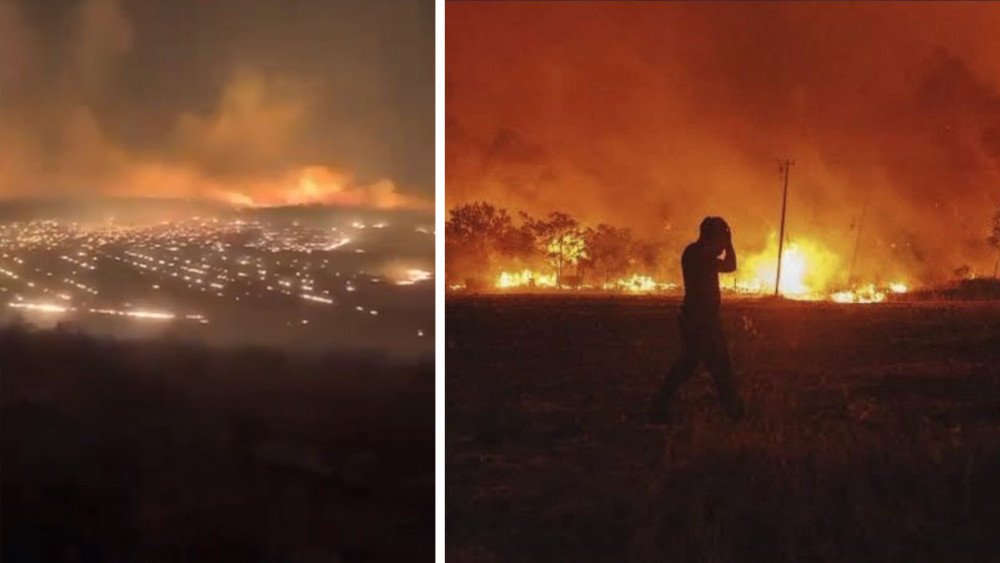
Regions of Turkey engulfed in flames
According to representatives of the country's parliament, to combat the forest fires, the largest aerial fleet in history was created: 105 helicopters, 26 airplanes, and 14 UAVs (unmanned aerial vehicles). Turkey became the first European country to use drones to fight forest fires. Drone footage helps detect and monitor fires using special software awarded by the International Telecommunication Union of the UN.
High temperatures that have settled in the country increase the number of natural fires.
In just 3 weeks, from June 1 to June 21, this year, 399 fires were recorded.
This is almost
5 times more than last year,
when 84 forest fires occurred during the same period. The area of burned territory in Turkey in 2024 has also significantly increased compared to last year.
Russia
The powerful storm Edgar hit the capital of Russia, causing torrential rains and destructive winds with speeds up to 25 m/s. Within minutes, Moscow plunged into chaos.
The cloudburst was more reminiscent of a tropical downpour than precipitation typical for temperate latitudes. Within 20 days of June, more than 185 mm of precipitation fell in the capital region, setting a new record for the last 82 years. Meteorologists have already called June 2024 the wettest in the history of meteorological observations.
The most destruction was caused by hurricane winds, sweeping everything in their path. People clung to poles and crawled on all fours to avoid being blown away.
In Moscow and the Moscow region, the wind uprooted more than 1,800 trees,
damaged hundreds of cars.
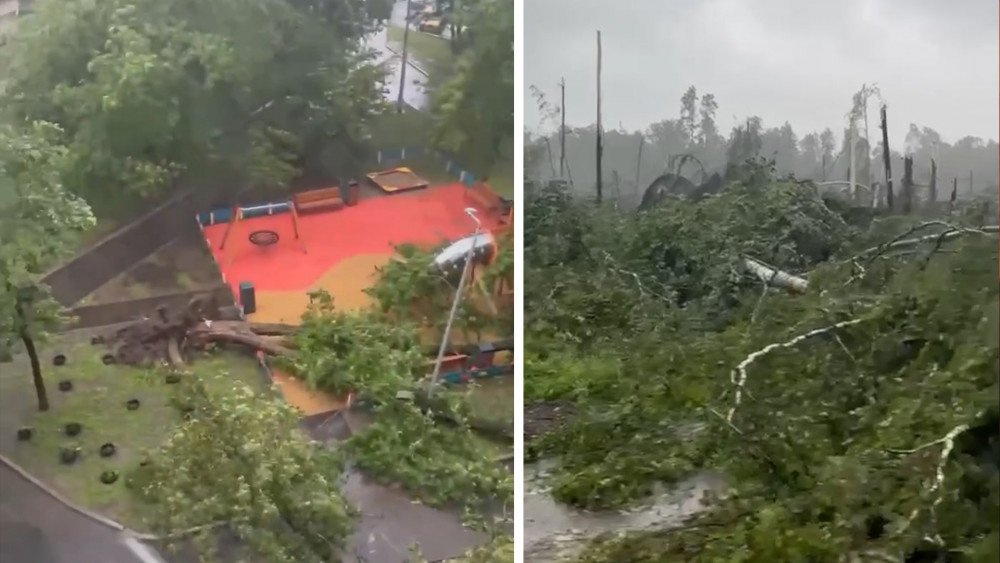
Strong wind in Moscow and the Moscow region toppled hundreds of trees, Russia
Torn roofs and broken windows of houses, twisted fences and damaged cars, — this is the scene left by the storm Edgar.
For the second time in a month, tornadoes formed, which were spotted by residents of "New Moscow." Funnel clouds were also recorded in the Moscow region: in the cities of Istra, Losino-Petrovsky, and Lobnya. This is an absolutely atypical phenomenon for the region. As a result of the storm, two people died and at least 37 were injured.
On June 26, passenger train No. 511, traveling from Vorkuta to Novorossiysk, crashed near the Inta station in the Republic of Komi. At the time of the accident, the train was carrying 232 people, many of whom were traveling to vacation on the Black Sea coast.
The crash occurred due to erosion of the railway track by abnormally strong rains that lasted for several days.
9 out of 14 cars derailed at full speed
and overturned.
Three passengers died, 70 were injured, and 10 people were in serious condition.

Train crash due to the washed out railway track, Republic of Komi, Russia
To assist the injured, a special emergency train was sent, as it was impossible for doctors and rescuers to reach the crash site due to the lack of roads in the impassable taiga and marshlands.
There was an attempt to send to Novorossiysk 5 carriages with passengers who were not injured in the accident. However, the train could not continue due to the washout of the railway track in another section of the route.
Balkan countries
On June 21, there were massive power outages in the Balkan Peninsula countries: Bosnia and Herzegovina, Montenegro, Albania, and Croatia.
In this region, temperatures of
40 degrees Celsius persisted for several days.
Due to high temperatures, energy consumption sharply increased, overloading the power grids and causing their failure.
Such a large-scale outage occurred in the region for the first time.
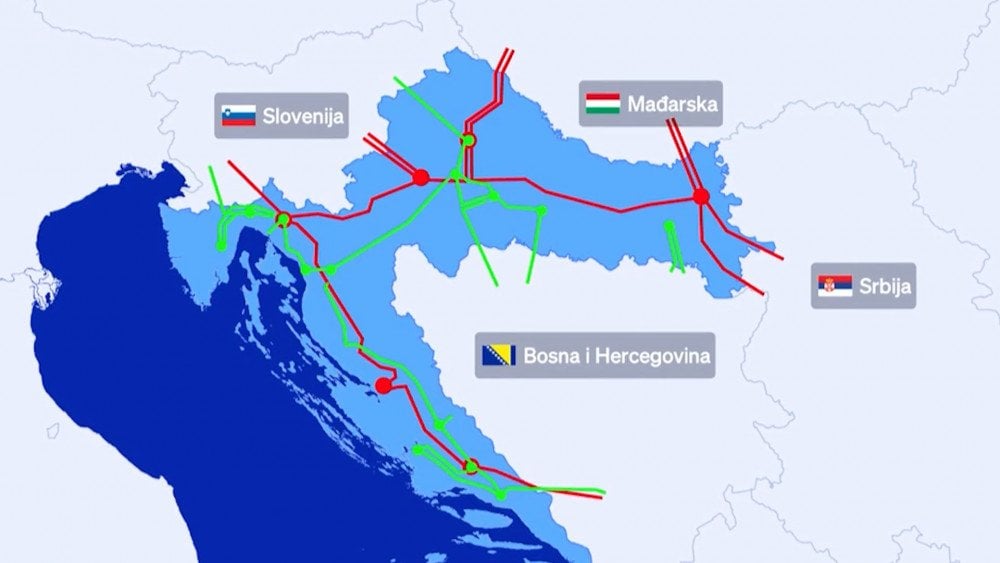
Major power grid failure in the Balkan countries
This led to a real collapse in the Balkans. In the capital of Bosnia and Herzegovina, Sarajevo, trams stopped, traffic lights stopped working. Many people were stuck in elevators.
In the Croatian city of Split, traffic jams formed throughout the city, preventing even emergency vehicles from passing.
Thousands of tourists who came to the city of Dubrovnik in Croatia faced the fact that all places of rest, cafes, and even supermarkets had to close. Football fans could not watch the European Championship games in pubs due to the power outage. The economy of the tourist city was severely affected by the weather anomaly.
In the city of Podgorica, Montenegro, many residents were left without water because the pumps stopped working, and a shutdown of air conditioners only exacerbated the impact of the heat.
Romania introduced weight restrictions for vehicles traveling on national roads. These measures are necessary to prevent the destruction of the road surface, which begins to melt due to abnormal heat, and heavy transport can deform it.
After the abnormal heat, a wave of storms with strong winds, heavy rains, and unusually large hail swept across several European countries.
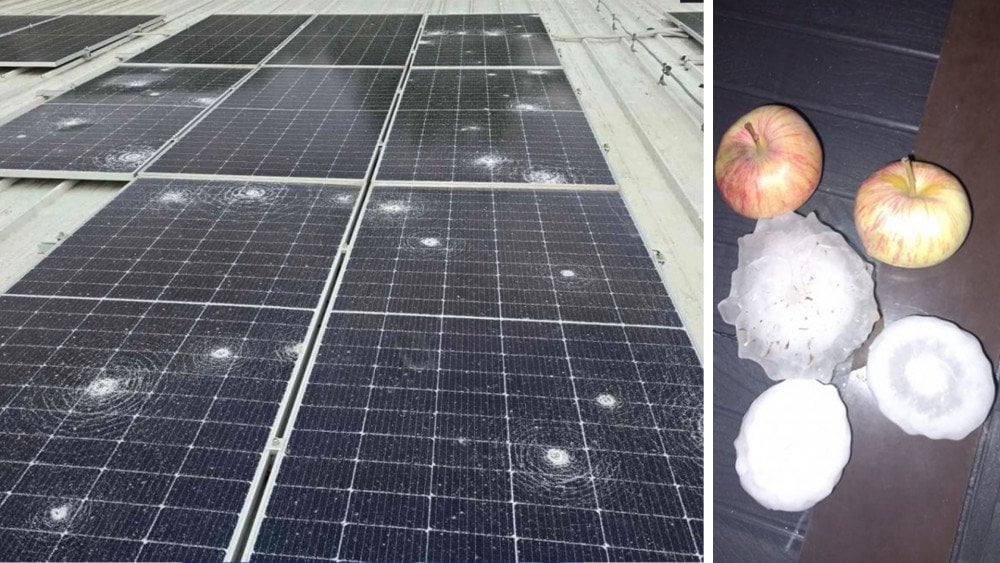
Power station damaged by large hail, Doboj-Istok community, Bosnia and Herzegovina
June 22
hail the size of an apple
caused major damage to the Doboj East community in Bosnia and Herzegovina. Agricultural crops, fruit gardens, greenhouses were affected. 12 solar power stations were damaged. Hail damaged cars, broke tiles on the roofs of many residential houses, polyclinics, schools, and factories. Now the buildings are not protected from rain, which may lead to further damage.
Czech Republic
On the same day in the Czech Republic, powerful storms with torrential rains and
large hail up to 10 cm in size occurred.
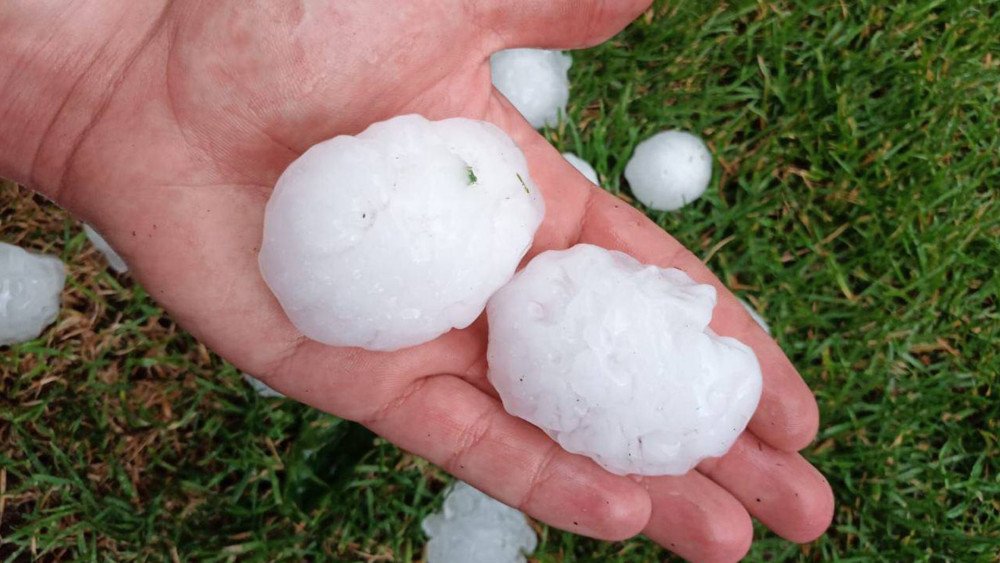
Large hail in the Czech Republic
At Mošnov airport, the wind reached speeds of 100 km/h. And in the city of Brno, at the Brno-Žabovřesky weather station, up to 25 mm of precipitation fell in 10 minutes. Water poured from the ceiling during a concert at the Janáček Theatre.
Also, the Punkva Caves in the Moravia region were flooded, so they had to be closed to tourists.
People were so shocked by the weather event that mass inquiries about the weather caused the website of the Czech Hydrometeorological Institute to crash.
The following information was published on the website: "Unfortunately, a huge number of visitors caused the system overload, and not only we but also other organizations dealing with weather in the Czech Republic experienced functionality problems."
France
Several days of torrential rains and intense snowmelt in the mountains caused catastrophic damage to the Écrins National Park in France. It's worth noting that the park had only recently been restored after the devastating floods of 2023.
On the night of June 21, the popular tourist destination, the village of La Berarde, known as the Mecca of mountaineering, was washed away by a stream of water and stones.
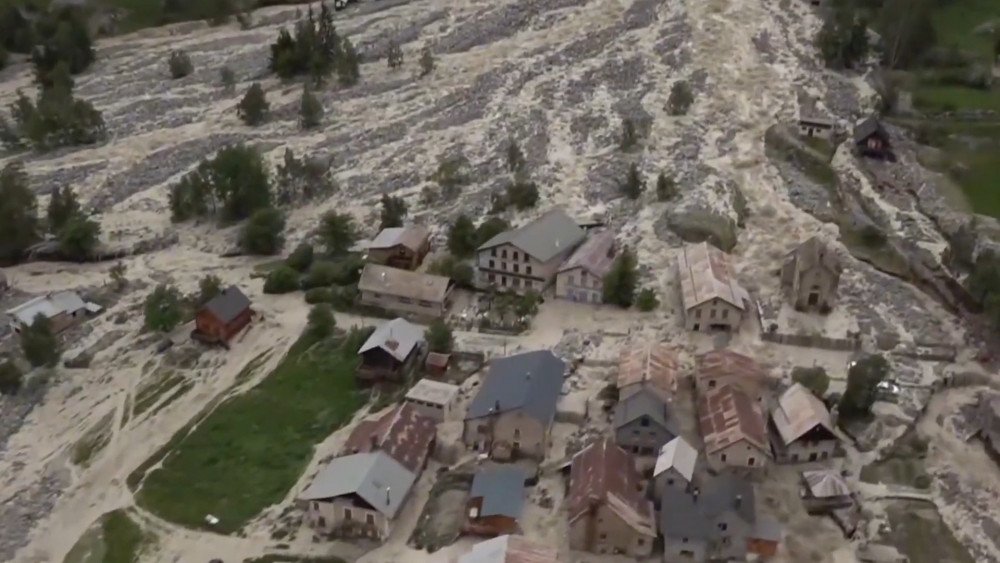
Water and stone streams wash away the village of La Berarde, France
Almost nothing was left of the village, roads became impassable, the only bridge connecting La Berarde and Saint-Christophe-en-Oisans was destroyed, leaving 97 people stranded.
Climbers, tourists, and local residents were timely evacuated with the help of 4 helicopters. Landline and mobile communications were damaged, complicating rescue operations.
Local residents are in despair because their tourism business was completely destroyed by the natural disaster.
Switzerland
Strong storms and rains caused a sudden flood and landslide in southeastern Switzerland. One person died and two are missing.
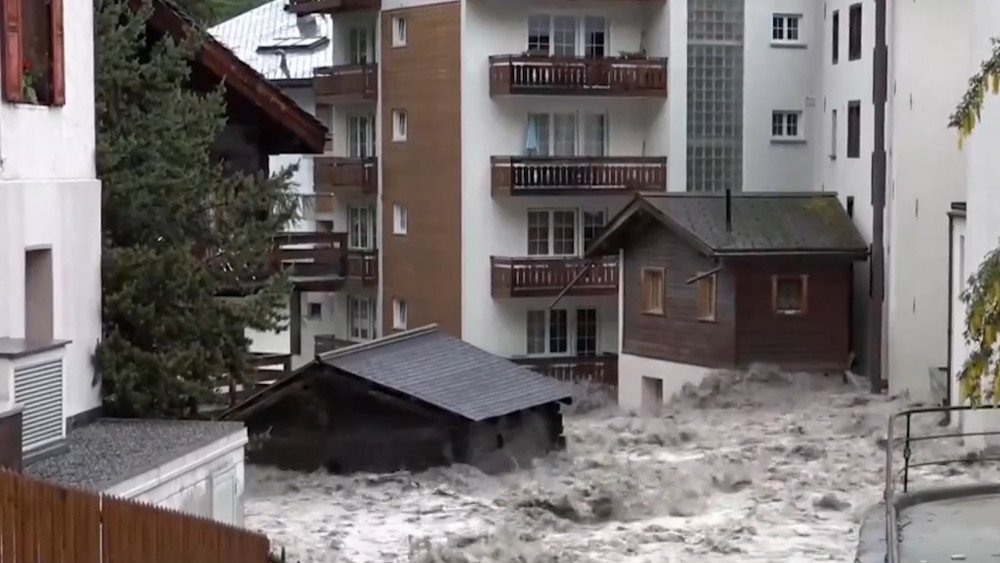
Flooded resort Zermatt, Switzerland
From June 21, the famous Swiss resort of Zermatt was completely cut off from the world due to the overflow of the Vispa River.
According to the Federal Office of Meteorology and Climatology, 124 mm of rain fell that day (the average monthly norm for June is 62.3 mm), which constitutes two monthly norms of rainfall, most of it falling within just one hour. "This concentration of rain happens only once every 30 years," said a representative of the Office.
According to the European database of hazardous weather events, from 2000 to 2004, there were 661 cases of abnormal precipitation in Europe, but from 2019 to 2023, there were 29,031, which is 44 times more!
This information can be found in the report
"On the progression of climatic disasters on Earth and their catastrophic consequences." The report contains a vast amount of facts about the impending disaster.
If the majority of the planet's population becomes aware of the information outlined in the report, it is highly likely that all wars will cease. People will realize: what's the point of dividing a house and deciding who's the boss if the house will cease to exist soon? It's much better to find common ground and save this house together. Then people will understand that unity is much more beneficial, safer, and more interesting than feuding and destroying each other.
It is with information that all global changes begin. It is now important to study it and share it with those around you.
This will be a huge contribution to preserving your own life and the lives of your loved ones.
You can view the video version of this article here.
Leave a comment